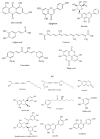Insight into the Biological Roles and Mechanisms of Phytochemicals in Different Types of Cancer: Targeting Cancer Therapeutics
- PMID: 37049544
- PMCID: PMC10097354
- DOI: 10.3390/nu15071704
Insight into the Biological Roles and Mechanisms of Phytochemicals in Different Types of Cancer: Targeting Cancer Therapeutics
Abstract
Cancer is a hard-to-treat disease with a high reoccurrence rate that affects health and lives globally. The condition has a high occurrence rate and is the second leading cause of mortality after cardiovascular disorders. Increased research and more profound knowledge of the mechanisms contributing to the disease's onset and progression have led to drug discovery and development. Various drugs are on the market against cancer; however, the drugs face challenges of chemoresistance. The other major problem is the side effects of these drugs. Therefore, using complementary and additional medicines from natural sources is the best strategy to overcome these issues. The naturally occurring phytochemicals are a vast source of novel drugs against various ailments. The modes of action by which phytochemicals show their anti-cancer effects can be the induction of apoptosis, the onset of cell cycle arrest, kinase inhibition, and the blocking of carcinogens. This review aims to describe different phytochemicals, their classification, the role of phytochemicals as anti-cancer agents, the mode of action of phytochemicals, and their role in various types of cancer.
Keywords: cancer therapeutics; cell signaling; natural products; phenolic compounds; phytochemicals.
Conflict of interest statement
The authors declare no competing financial interest.
Figures





Similar articles
-
A rapid and systematic review of the clinical effectiveness and cost-effectiveness of paclitaxel, docetaxel, gemcitabine and vinorelbine in non-small-cell lung cancer.Health Technol Assess. 2001;5(32):1-195. doi: 10.3310/hta5320. Health Technol Assess. 2001. PMID: 12065068
-
InterPAD is a database of drug-drug interaction between phytochemicals and anticancer drugs.Sci Rep. 2025 Jul 9;15(1):24616. doi: 10.1038/s41598-025-10240-6. Sci Rep. 2025. PMID: 40634546 Free PMC article.
-
Phytochemicals in Inhibition of Prostate Cancer: Evidence from Molecular Mechanisms Studies.Biomolecules. 2022 Sep 16;12(9):1306. doi: 10.3390/biom12091306. Biomolecules. 2022. PMID: 36139145 Free PMC article.
-
The Black Book of Psychotropic Dosing and Monitoring.Psychopharmacol Bull. 2024 Jul 8;54(3):8-59. Psychopharmacol Bull. 2024. PMID: 38993656 Free PMC article. Review.
-
Management of urinary stones by experts in stone disease (ESD 2025).Arch Ital Urol Androl. 2025 Jun 30;97(2):14085. doi: 10.4081/aiua.2025.14085. Epub 2025 Jun 30. Arch Ital Urol Androl. 2025. PMID: 40583613 Review.
Cited by
-
Hyaluronic Acid-Mediated Phenolic Compound Nanodelivery for Cancer Therapy.Pharmaceutics. 2023 Jun 16;15(6):1751. doi: 10.3390/pharmaceutics15061751. Pharmaceutics. 2023. PMID: 37376199 Free PMC article. Review.
-
Pharmacological potential of bioactive compounds in Catharanthus roseus extract: A comprehensive review.Toxicol Rep. 2025 Mar 17;14:101998. doi: 10.1016/j.toxrep.2025.101998. eCollection 2025 Jun. Toxicol Rep. 2025. PMID: 40213418 Free PMC article. Review.
-
Regulation of Matrix Metalloproteinases by Wine-Derived Compounds: Implications for Cancer Therapy.Biomolecules. 2025 May 28;15(6):781. doi: 10.3390/biom15060781. Biomolecules. 2025. PMID: 40563423 Free PMC article. Review.
-
Exploring the potential of tocopherols: mechanisms of action and perspectives in the prevention and treatment of breast cancer.Med Oncol. 2024 Jul 26;41(9):208. doi: 10.1007/s12032-024-02454-x. Med Oncol. 2024. PMID: 39060448 Review.
-
Inhibition of Kinase Activity and In Vitro Downregulation of the Protein Kinases in Lung Cancer and Cervical Cancer Cell Lines and the Identified Known Anticancer Compounds of Ziziphus mucronata.Plants (Basel). 2025 Jan 28;14(3):395. doi: 10.3390/plants14030395. Plants (Basel). 2025. PMID: 39942957 Free PMC article.
References
-
- Woo Y.M., Shin Y., Lee E.J., Lee S., Jeong S.H., Kong H.K., Park E.Y., Kim H.K., Han J., Chang M., et al. Inhibition of aerobic glycolysis represses Akt/mTOR/HIF-1α axis and restores tamoxifen sensitivity in antiestrogen-resistant breast cancer cells. PLoS ONE. 2015;10:e0132285. doi: 10.1371/journal.pone.0132285. - DOI - PMC - PubMed
Publication types
MeSH terms
Substances
Grants and funding
LinkOut - more resources
Full Text Sources
Medical

